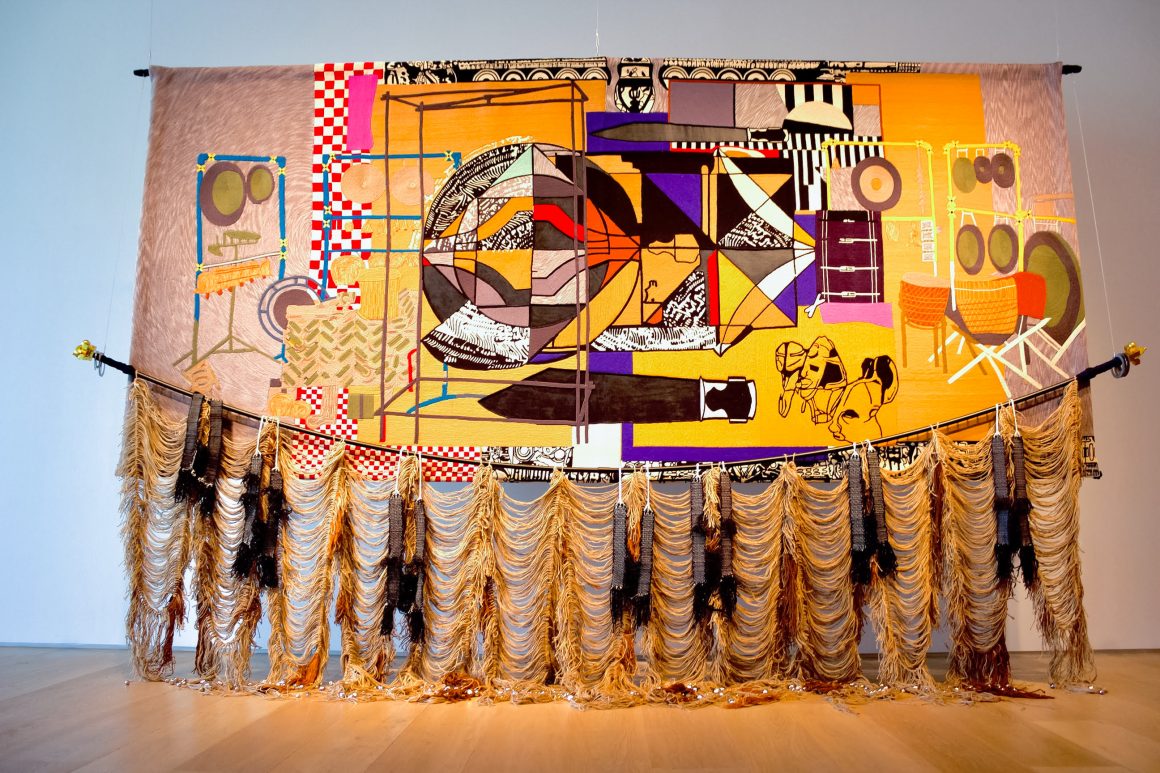
Esker Foundation launches Fall exhibitions
By Troy Hasselman, October 15 2019 —
The Esker Foundation has opened their fall season, including exhibitions from high-profile artists Nep Sidhu and recent MacArthur Genius Grant Recipient Jeffrey Gibson having opened on Sept. 27. A new exhibition from multi-disciplinary Kainai/Secwépemc artist Marie Crop Eared Wolf will open on Oct. 28 in the Esker Foundation Project Space.
Jeffrey Gibson’s Time Carriers and Nep Sidhu’s Divine in Form, Form in the Divine (Medicine for a Nightmare) are both multi-disciplinary pieces that have thematic similarities. The similarities between the themes of the two exhibitions are intentional.
“Both of the artist’s works deal with rewriting narratives, examining histories, issues surrounding identity but also broad issues around justice, representation and healing,” says Esker Foundation marketing and communication head Jill Henderson. “Both are articulating some complex histories and contemporary struggles in their work. Gibson has been influenced by the “Black Lives Matter” movement and also his personal background. A lot of his work references things like pow-wow regalia and jingle dresses as well as music and drumming. Music and drumming also connects with Nep’s Sidhu’s work.”
Time Carriers makes extensive use of quilt-making that takes influence from Indigenous cultures. The work will include garments and photographs as part of an exhibition that focuses on Gibson’s own cultural background.

Installation view of Jeffrey Gibson’s exhibition Time Carriers at Esker Foundation. // Photo by Cheyanne Lemaire.
“Jeffrey Gibson is a queer Native American artist and has been making textile-based work for about 15 years,” Gibson says. “His work is very well recognized in the United States, he was just awarded a MacArthur Fellow Genius Grant which came a $625,000 award. Articles on Gibson’s work can be in the Washington Post and the New York Times. We’re exhibiting his quilt pieces, they are very large in format and detailed. We also have a series of photographs where he’s made fantastic garment items and there’s portrait photographs of people wearing those and also other large-scale fabric pieces.”
Fifty garments and drums that are part of the exhibit will be used on Oct. 19 in a performance called To Name An Other at the Atlantic Avenue Art Block where the Esker Foundation is located. The piece was commissioned by the National Portrait Gallery in Washington D.C. earlier this year and has also been performed at the New Museum in New York.
“We’ve put a call out for the 50 persons involved in the performance,” Henderson says. “Each will have a certain phrase or a few words to say and will work with Jeffrey Gibson, recite the words, drum and be a part of the performance.”
Divine in Form, Form in the Divine (Medicine for a Nightmare) is a mid-career survey of Nep Sidhu’s work which focuses on memory, grief, loss and divinity. The pieces draw from throughout Sidhu’s career and use material from a variety of mediums.
“With Nep Sidhu, we have a whole series of mannequins with incredible clothing and garment items,” Henderson says. “We also have three very large scale sculptures, three other hat-head pieces with hats and detailed metalworks and three large-scale tapestries.”
The exhibition as well includes a newly commissioned film from Sidhu called Black (W)hole, which is premiering as part of the exhibition. The film focuses on legendary jazz-harpist and composer Alice Coltrane and her lifelong search for an uninterrupted melody.
The fall season will also include the end of the display of Kablusiak’s Qiniqtuaq, which opened on July 29 and will finish its run on Oct. 20.
“The exhibition comprises of a large sheet with ‘Ghost-type’ eye holes and multiple eye holes throughout,” Henderson explains. “There’s a video projection, you view the pproejctions through the holes which is easier to see in the evening. There are excerpts of lots of videos and television programs like The Simpsons and Seinfeld to Inuit Broadcasting Corporation programs, those are also programs that Kablusiak watched and are related to them. But also, a history of shows they’ve watched in childhood which are interpreted with television images of Inuit persons.”

Installation view of Nep Sidhu’s exhibition Divine of Form, Formed in the Divine (Medicine for a Nightmare) at Esker Foundation. // Photo by Cheyanne Lemaire.
Marjie Crop Eared Wolf’s Iitsi’poyi will open on Oct. 28 and will run until Jan. 26, 2020. The exhibition deals with themes of language, technology and tradition.
“Marjie is working with an art project with her mother,” Henderson explains. “It’s related to learning Blackfoot. Teaching herself words and phrases in Blackfoot and writing and re-learning those things for herself. There’s video work and repetitive writing. Being as this is the United Nations International Year of Indigenous Languages, it is a pointed moment to be working with language. It is all words transcribed from the Blackfoot dictionary and it closely relates to her family and her learning a language.”
This fall, the Esker Foundation is also launching Esker Youth Engagement, a new initiative which includes free public programs and educational courses to youths in Calgary. Programs part of the initiative include Plant Medicine for Dreaming on Oct. 11, a class taught by Sachin Sudra which teaches how to make essential oils and balms. Protest Signs, Pins & Tees is a workshop that runs on Nov. 22 from artists Jane Trash and Sondra Meszaros which focuses on making pins, signs and tees as personal protest objects. Introduction to DJing will be a DJing workshop on Dec. 6, taught by Richard Sparvier a.k.a. DJ BLKFT of Drum Beat Productions and host of CJSW’s Bannock n’ Jams.
The season will also include numerous artist talks and workshops that will occur in partnership with Indigneous fashion festival Otahpiaaki. Esker will partner with them on seven different workshops that will occur throughout the season.
The Esker Foundation is located 1011 9 Ave S.E and is open Tues.–Sun. from 11 a.m.–6 p.m. Admission is free. For more information about their autumn exhibitions and a schedule for performances, talks and workshops, visit their website.
